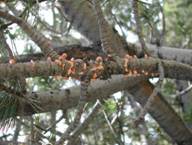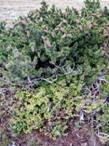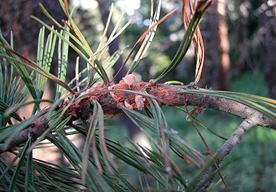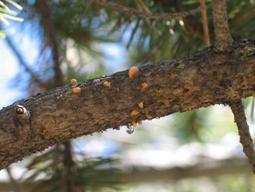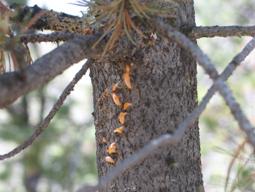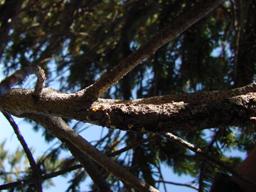WHITE PINE BLISTER RUST
Description
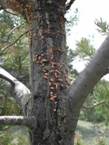 A major threat to high elevation white pines and their ecosystems is a non - native fungus (Cronartium ribicola) that causes the disease white pine blister rust. All of the North American white pines are susceptible to the rust. In those species studied, they show low levels of resistance and high mortality rates in all cases.
A major threat to high elevation white pines and their ecosystems is a non - native fungus (Cronartium ribicola) that causes the disease white pine blister rust. All of the North American white pines are susceptible to the rust. In those species studied, they show low levels of resistance and high mortality rates in all cases.
The rust, native to Asia, was introduced to North America around the turn of the twentieth century. Since its introduction, it has spread to 38 states and caused substantial damage and mortality especially in commercially valuable species of white pine. The disease continues to spread into high elevation areas where the effects go beyond the loss of individual trees. The cascading effects on associated plant and animal communities throughout the affected ecosystems have been observed.
Referred Literature: 1, 85
Disease cycle & alternate hosts
White pine blister rust has a complex life cycle that requires two hosts, a white pine and, most commonly, a currant or gooseberry plant (Ribes ssp.). But recently indian paint brush (Castillija spp.) and snapdragon (Pedicularis spp.) have been discovered to be alternate hosts as well. All species of white pine are susceptible at all ages; however seedlings and young trees are often more easily infected and die more quickly as a result of infection. The following schematic depicts a simplified version of the life cycle of white pine blister rust.
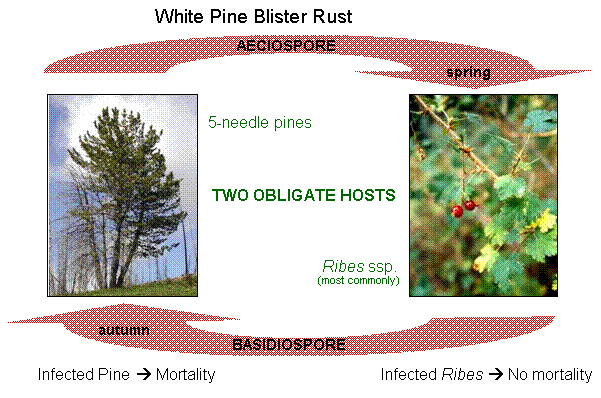
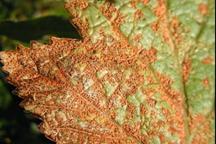 Generally, white pine blister rust spores germinate on the plant surface and grow into the pine through the stomatal openings in the needles or a through a wound. The fungus then grows into the twig. The infected branch will often swell; after a year or more, the rust forms spores that are contained in blister - like sacks that erupt through the bark of the twig or stem. When the blisters rupture they release bright orange colored aeciospores which infect the alternate host (most commonly gooseberry or currant
Generally, white pine blister rust spores germinate on the plant surface and grow into the pine through the stomatal openings in the needles or a through a wound. The fungus then grows into the twig. The infected branch will often swell; after a year or more, the rust forms spores that are contained in blister - like sacks that erupt through the bark of the twig or stem. When the blisters rupture they release bright orange colored aeciospores which infect the alternate host (most commonly gooseberry or currant  plants). While hosted on these other plants the rust produces basidiospores that are released in the fall and can infect the pines. The rust is shed from the gooseberry or current plant when the plant naturally drops its leaves in the autumn.
plants). While hosted on these other plants the rust produces basidiospores that are released in the fall and can infect the pines. The rust is shed from the gooseberry or current plant when the plant naturally drops its leaves in the autumn.
In contrast, one successful rust infection of a pine can persist and expand for years. Once inside the pine needle the fungus grows down to the twig and into the branch and ultimately to the main stem of the tree. The damage caused by the rust killing the cambium causing a canker, girdles the stem which prevents water and nutrients from passing through the canker area; as a result the distal portion of the twig, branch or stem dies. If the canker forms on the main stem, it will cause topkill and often causing the tree to die.
 It can take years for the disease to kill a large tree. During the progression of the disease branch death and topkill can significantly reduce cone and seed production and tree vigor. The pathogen can kill small trees within just a few years. Unlike bark beetles that attack only mature trees, blister rust threatened multiple aspects of the regeneration process by not only reducing available seed but also causing seedling mortality. As a result, white pine blister rust can threaten the sustainability of high elevation white pine stands.
It can take years for the disease to kill a large tree. During the progression of the disease branch death and topkill can significantly reduce cone and seed production and tree vigor. The pathogen can kill small trees within just a few years. Unlike bark beetles that attack only mature trees, blister rust threatened multiple aspects of the regeneration process by not only reducing available seed but also causing seedling mortality. As a result, white pine blister rust can threaten the sustainability of high elevation white pine stands.
The severity and rate of infection is not uniform across the landscape; due in part to the biology of the pathogen and the conditions required for successful spore production, transport and germination. The spores can be damaged by dry air; therefore wet, cool conditions during spore shedding can lead to successful infection.
More detailed information on White Pine Blister Rust
Referred Literature: 1, 127
Impacts
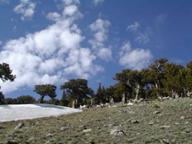 There are environmental, socio-economic, ecological, scientific, and aesthetic impacts of the loss of the highly valued high elevation white pines. While the rust will not likely eliminate all high elevation white pines ecosystems, it will impact the species distribution, population dynamics and the functioning of the ecosystems.
There are environmental, socio-economic, ecological, scientific, and aesthetic impacts of the loss of the highly valued high elevation white pines. While the rust will not likely eliminate all high elevation white pines ecosystems, it will impact the species distribution, population dynamics and the functioning of the ecosystems.
Economically, these pines are not typically used for lumber or pulp but have enhanced the beauty of many national parks, wilderness and wild areas. In central Colorado, over 100,000 people a year pay an entrance fee to visit an ancient bristlecone pine forest in a Research National Area. Currently, stands of dead and dying whitebark pine trees can be seen 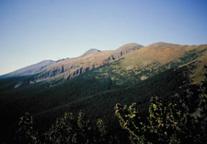 in several western parks (e.g., Crater Lake, Glacier, and North Cascades). This devastation may begin to affect the tourist economies of adjacent communities.
in several western parks (e.g., Crater Lake, Glacier, and North Cascades). This devastation may begin to affect the tourist economies of adjacent communities.
Ecologically, high elevation white pines play a critical role in maintaining a range of wildlife and plant species. As these pines continue to decline, it can affect the diversity of wildlife and plant species that depend on them for food and cover. The large seeds produced by many of these species are and important food source for the Clarks nutcracker and similar birds and grizzly and black bear. The decline of pine species will likely affect squirrel populations and the carnivore species that depend on them, including possibly Canada Lynx.
Mortality caused by rust on harsh, steep, dry sites will likely transition these forested sites to treeless areas affecting slope stability, snow retention and watershed hydrology. On wet sites, the loss of high elevation white pines will alter future forest composition and successional pathways. The ultimate overall result being more homogeneous forests, changes in fire regimes, and reduced wildlife diversity.
Ecological Roles of Five - Needle Pines in Colorado: Potential Consequences of Their Loss
Referred Literature: 85,95,1
Symptoms
Symptoms of white pine blister rust infection may be difficult to spot at first; it may simply appear as small yellow or red spots on a few needles. Usually within a few years cankers can be found on the branches. These cankers will generally appear as a swollen area that may have a greenish - yellow to orange margin. As the cankers mature they will girdle the branch or stem causing death of living tissue beyond that point. The distinctive orange blisters are visible in later spring and early summer.
Some general symptoms include:
Branch swelling - Small branches produce a spindle - shaped swelling with a new infection
Branch flagging - Branches die distal to cankers; needles turn orange & fall off
Orange Blisters - Blisters of orange spores on cankers (in spring) and branch swellings
Cankers - Diamond - shaped cankers on trunks; greenish - yellow to orange margin (mature)
Resin flow - Branches and trunk on advanced infections can have streams of resin
Chewing - Rodent - feeding on cankers
The symptoms may appear slightly different on each of the high elevation species.
Limber Pine
Rocky Mountain Bristlecone Pine
Whitebark Pine
Foxtail Pine
Great Basin Bristlecone pine
No infection have been found in wild trees at this time (2005)
For more information:
How to Identify White Pine Blister Rust on Whitebark Pine
Resources: 104, 124, 126
Current distribution

History of Infection
The fungus is native to Asia and was introduced to the eastern and western coasts, respectively, of North America around the turn of the 20th century on infected white pine seedlings grown in Europe. The disease continues to spread into new communities of white pine species causing substantial damage and mortality. The following graphic and timeline give a more detailed description of historical events leading up to the current status of white pine blister rust infection in North America today. The year in parentheses is the first year the disease was observed in native forest trees of that species.
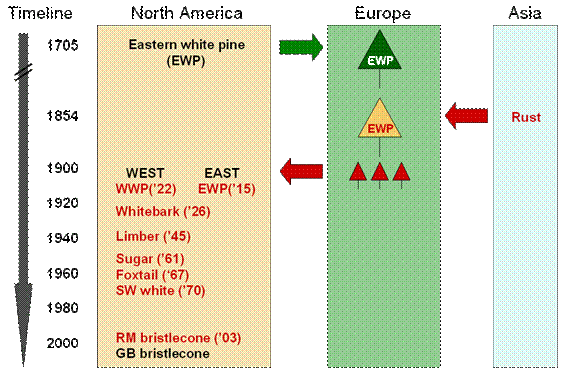
Timeline of White Pine Blister Rust Events
Date |
Event |
1854 |
Blister rust observed in Baltic Province of Russia |
1861 |
Blister rust observed in Finland |
1865 |
Blister rust observed in East Germany |
by 1900 |
Blister rust is present throughout northern Europe |
1890 - 1914 |
Forest nurseries in France & Germany sell eastern white pine seedlings to North American foresters |
1906 |
Blister rust observed on currants (Ribes ) in Geneva, New York. |
1909 |
Blister rust observed on seedlings in several locations along the eastern coast of North America |
1921 |
Blister rust observed on western coast of North America in Vancouver, British Colombia |
1923 |
Disease spreads eastward into Idaho |
1926 |
Blister rust first observed on a high elevation pine (Whitebark pine) |
1927 |
Disease spreads into northwestern Montana |
1929 |
Disease spreads to southern Oregon |
1939 |
Disease observed in Glacier National Park |
1941 |
Disease spreads to the northern Sierra Nevada mountains in California |
1945 |
Disease reaches southern Idaho |
1961 |
Disease spreads to the southern Sierra Nevada mountains in California |
1967 |
Blister rust observed on foxtail pine in northern California |
1970 |
Disease spreads to New Mexico (southwestern white pine) and southern Wyoming (limber pine) |
1998 |
Disease observed in Northern Colorado (limber pine) |
2003 |
Blister rust observed on Rocky Mountain bristlecone pine in central Colorado more than 200 miles from the nearest infected area. |
Source: 86, 127
The history of white pine blister rust infection
White pine blister rust brochure

